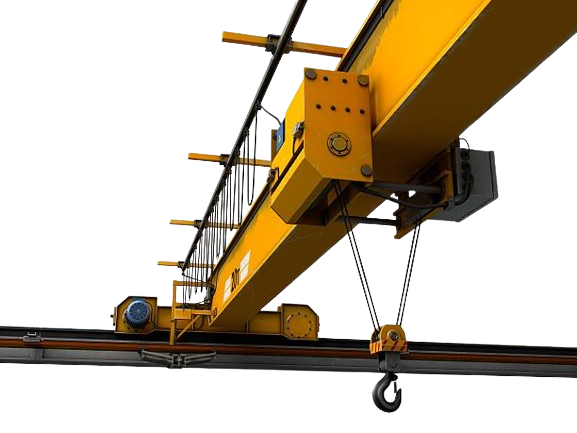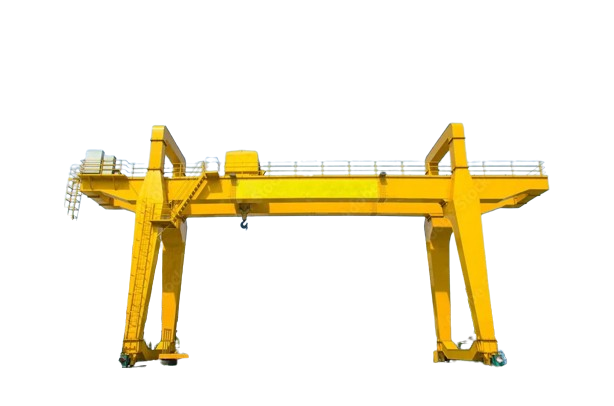- January 17, 2024
- Adarsh Microtech
- 0 Comments
- 252 Views
- 0 Likes
- Uncategorized
EOT Crane
What is EOT (Electric Overhead Travelling) Crane ?
An EOT crane, also known as a bridge crane, is a type of heavy machinery used to lift and move materials in a horizontal direction. It’s a common sight in factories, warehouses, and shipyards, where it helps with tasks like:
- Loading and unloading trucks and ships
- Moving heavy machinery and equipment
- Assembling large objects
- Positioning materials for processing

What are the parts of EOT Crane?
An Electric Overhead Travelling (EOT) Crane consists of several key parts that work together to enable efficient lifting and movement of heavy loads in industrial settings. Here are the main components:
- Bridge Girder: The bridge girder is the horizontal beam that spans the width of the crane and provides support for the other components. It travels along the runway rails and supports the lifting mechanism.
- End Carriages: Attached to each end of the bridge girder, end carriages house the wheels that run on the runway rails. They facilitate the horizontal movement of the crane along the length of the runway.
- Runway Rails: These are parallel tracks installed on the overhead structure to guide the movement of the crane. The wheels on the end carriages roll along these rails, allowing the crane to travel along the length of the runway.
- Hoist Mechanism: The hoist mechanism is responsible for lifting and lowering the load. It includes a hoist motor, drum, and wire rope or chain. The drum winds or unwinds the rope or chain, raising or lowering the hook or other lifting attachment.
- Trolley: The trolley is a movable unit that travels across the bridge girder. It carries the hoist and hook assembly, allowing the load to be positioned anywhere along the length of the bridge.
- Hoist Motor: The hoist motor provides the power needed to lift and lower heavy loads. It is a crucial component of the hoist mechanism and is controlled by the operator.
- Electrical Panel: The electrical panel contains the control devices and circuits that manage the crane’s movement. It includes switches, buttons, and sometimes a remote control unit for the operator to control various crane functions.
- Limit Switches: Limit switches are safety devices that set boundaries for the crane’s movement. They prevent over-travel of the crane and ensure it stops at the desired positions, enhancing safety during operation.
- Brakes: Brakes are installed on the bridge and trolley wheels to control and stop the crane’s movement. They play a crucial role in ensuring the crane stops precisely when needed.
- Load Block or Hook: The load block, often in the form of a hook, is the attachment that holds and lifts the load. It is connected to the hoist mechanism and is designed to securely hold the load during lifting and movement.
Understanding these components helps in comprehending the functionality of an EOT Crane. Each part plays a vital role in ensuring the crane’s stability, precision, and safety during lifting operations.

Types of EOT Cranes
- Double Girder EOT Cranes
- Single Girder EOT Cranes
- Goliath Crane
- Single Beam EOT Crane
- Double Beam EOT Crane
Double Girder EOT Cranes
- Power Source: Electric
- Max Height: 0-20 feet, 20-40 feet, 40-60 feet
- Span: Up to 35 mtr
- Hoist Travelling Speed: up to 10 m/min
- Capacity: 5-10 ton,10-15 ton,15-20 ton,20-25 ton,>25 ton,125 ton
- Price: 3L to 4L

Single Girder EOT Cranes

- Capacity: 5-10 ton
- Power Source: Electric
- Max Height: 20-40 feet
- Span: 10-20 m
- Hoist Travelling Speed: 5-10 m/min
- Price: 2.5L to 3L
Goliath Crane
- Girder Type: Single
- Travel Speed: 5-10 m/min
- Span: 10-20 m
- Power Source: Hydraulic
- Country of Origin: Made in India
- Price: 3.8L to 10L

Advantage of using EOT Cranes
- Heavy Lifting Power: Lift and move heavy loads effortlessly.
- Versatility: Suitable for various industries and applications.
- Precision Handling: Ensure accurate and controlled material placement.
- Space Optimization: Utilize floor space efficiently with overhead installation.
- Increased Productivity: Streamline workflows for faster and efficient operations.
- Reliability: Durable and dependable, minimizing downtime.
- Enhanced Safety: Equipped with features like limit switches for accident prevention.
- Customizable: Tailor to specific load capacities and spans.
- Cost-Effective: Long-term efficiency and reduced manual labor contribute to cost savings.
The principle of Electric Overhead Travelling (EOT) Cranes involves a robust structure with a horizontal bridge girder supported by end carriages. Powered by an electric hoist, the crane travels along runway rails, enabling vertical lifting and horizontal movement. This design optimizes material handling efficiency across diverse industrial applications.
In cranes, LT (Long Travel) refers to the horizontal movement along the runway, covering the entire length. CT (Cross Travel) involves the horizontal movement perpendicular to the LT, allowing the crane to position loads precisely across the width of the working area.
ATB in a crane commonly refers to “Anti-Two-Blocking” system. It’s a safety feature that prevents the crane’s hook block from colliding with the boom tip, which could lead to serious damage or accidents. The ATB system helps ensure safe and efficient crane operations.
A QC (Quayside) Crane is a specialized type of crane commonly used in port facilities. It is designed for lifting and moving heavy cargo containers between ships and the quay (dock). QC Cranes play a crucial role in the efficient loading and unloading of containers at maritime terminals.


Leave a Comment